I ventured into the valley, not really expecting to come across anything spectacular (at least, not that I was already used to seeing each time I visited the place).
All I wanted to do that cold, December afternoon was play with my new Christmas present in the valley: a Canon Rebel T7 camera with two different lenses to test out. I wanted to take pictures of places and things I’d taken before with my iPhone over the years, just to see how much better (or worse) the Rebel did compared to my regular old iPhone.
Of course, I hoped I’d come across some wildlife, too. As beautiful and awesome as all aspects of the natural world often are, I didn’t want to just take pictures of sandstone rocks, moss and lichen, and winter branches. I wanted to get up close and personal with God’s wild creatures, and see if my new camera could do my experiences with them any justice.
The weather was cold, but not too cold. With a thin layer of clouds high above me, and no wind whatsoever, it was perfect weather for me. The first official day of winter was less than a week away, but the land was already in hibernation mode. All that remained of the visible grass was the stubble of last summer's mature grass. Most of the grass had lost their heads of seed, and all that remained were the shafts and dried, shriveled blades curled towards the ground. In the grass stubble along the whole western edge of the hogback, I recognized the dried remains of Rubber Rabbitbrush and Common Mullein sticking out of the golden sea here and there, but they were mostly hidden by the taller grass standing all around them.
Not every plant in that field of golden brown was dead and dried. There were patches of thriving Yucca plants, prickly pear cacti, moss, lichen, slime mold, and a handful of Red Cedars scattered among the dead grass. Crouching down into the field itself, I can already see the young, green blades of next year's grass and silver sage sticking out from the rich, red soil. To the untrained eye, the land looked dead and gone. But, in reality, it was just hibernating for the winter.
Right as I came up to the crest of the hogback, a tribe of noisy magpies drifted into the Gambel brush. At first, I wondered if there was something dead in those trees that attracted them. But, when I got closer to them, I realized that the magpies were enjoying a buffet of late-season acorns from the Gambel oaks on the grass below them. They’d peck holes into the shells of the acorns, and extract the seed “meat” to eat using their sharp black beaks and hook-like talons. Occasionally, a couple magpies would get too close together, and the feistier bird would chase the other away. I could almost hear that bird say, "Leave me and my damn acorns alone! This is my food!"
The magpies are loud, expressive creatures, making all sorts of different noises to communicate with each other. I swear, depending on where you are, magpies have regional accents. They're extremely intelligent animals who definitely speak their own unique language and have their own culture (such as funeral rituals and art). Perhaps, one day, I'll learn how to actually speak magpie.
Anyway...
I set my camera pack down on a barren sandstone seam that stuck up out of the soil, carefully removed my super expensive equipment from the pack, and attached the larger lens to the camera itself, so I could get some long-range shots of the birds and the valley as a whole. At least, that’s what I figured the longer lens was for (I really had no idea what I was doing).
After attaching the long-range scope- er I mean- lens to the camera, I aimed it at the magpies and tried to get some good, detailed shots of them as they scavenged the stubble grass for acorns. Unfortunately, due to my lack of experience, the height of the stubble grass, and the quick, jerky movements of the magpies, I struggled to get a good, detailed shot of the birds themselves with what I had.
I tried to get a good picture of the birds until they had all disappeared into the Gambel brush away from me, and out of sight of my camera. Unfortunately, all of the pictures came out blurry and unfocused on the birds for the most part (the camera kept zeroing in on the grass instead of than the birds). A for effort, I guess.

When the magpies were out of sight, I stood up to my full height and stared towards the north. From my point on the windward side of the hogback, I could see across the Ken Caryl and Willow Springs neighborhoods to Red Rocks. Straight east of Red Rocks was another hogback known as Mount Glennon (which is more of a state park rather than an actual mountain). Beyond that, Green Mountain (which is an actual mountain) rose above the entire landscape. In the valleys and prairies between myself and those massive natural formations, were neighborhoods of multi-million-dollar homes.
From my standpoint high above the valley, the houses looked much closer together than they really were. When the neighborhoods were designed, architects took great care when it came to putting the houses just close enough together to resemble a typical American suburb, but far enough apart to give room for nature to do its thing. As a result, Ken Caryl and Willow Springs have both become a haven for retirees and wildlife of all kinds.
Thankfully, we (as in the residents of Ken Caryl and Willow Springs) have learned how to respectfully coexist with nature with very few negative human-wildlife interactions. Occasionally, a bear or a cougar has to be tranquilized and relocated for getting too reliant on dumpster diving for food. But, as far as I'm aware, no one has ever been attacked by a huge wild animal in the valley or the springs (knock on wood), and the houses are designed to prevent wild animals from breaking in. Still, my head is always on a swivel when I'm hiking in the valley. Most of the time, the rustling I hear in the branches is a squirrel or a bird. Sometimes, however, it is something much bigger.
With my camera pack slung across my shoulders, and my camera in-hand and ready to shoot, I hiked further into the Gambel brush along the crest of the hogback, following the magpies as they moved further north down the trail. The magpies didn't seem to care that I was there. In fact, they were way too close for me to get a good picture with the lens I had, but I didn't think to switch to my close-up lens. I was simply too engrossed in the wilderness to stop and switch lenses.
I made sure to give the birds plenty of room to scavenge for acorns, but a couple magpies had no trouble coming up within petting distance to me. One of them even came right up to the toe of my hiking boot, and began to make noises that sounded a lot like a record being scratched, with clicks and snaps included.
"Sorry, buddy." I said aloud to the magpie who gazed up at me making all sorts of "feed me" noises, watching as I chewed on a stick of spearmint gum, "I've got nothin' for you. Go back to eating acorns with everyone else. Gum isn't good for you."
He seemed to understand and strutted away from me with his head in the stubble, looking for more acorns. Just as I asked him to.
A little further down the trail, away from the magpies, I heard another rustling noise ahead of me, so I paused.
Over the next few minutes, the rustling came gradually closer to me, though I couldn't see anything due to how thick the barren Gambel twigs were. Whatever was in those trees was very well-hidden. Until I saw its black and white snout poke out from the trees.
Soon, the whole deer came into view. I recognized her as one of the older muley does in the valley. I first saw her a couple springs before, when I just got back from living in Gig Harbor, Washington. This year (2022), she had two doe fawns, both of whom weren't far behind her as she came closer to me on the hogback.
Quickly, I got my camera turned on and aimed it at the familiar doe. However, I struggled to get the camera to focus on her, as she stood perfectly still and broadside to me, as though she was posing for the camera. She was just too close to me to get a good picture of her with the lens I had. My camera kept focusing on the brush behind her.
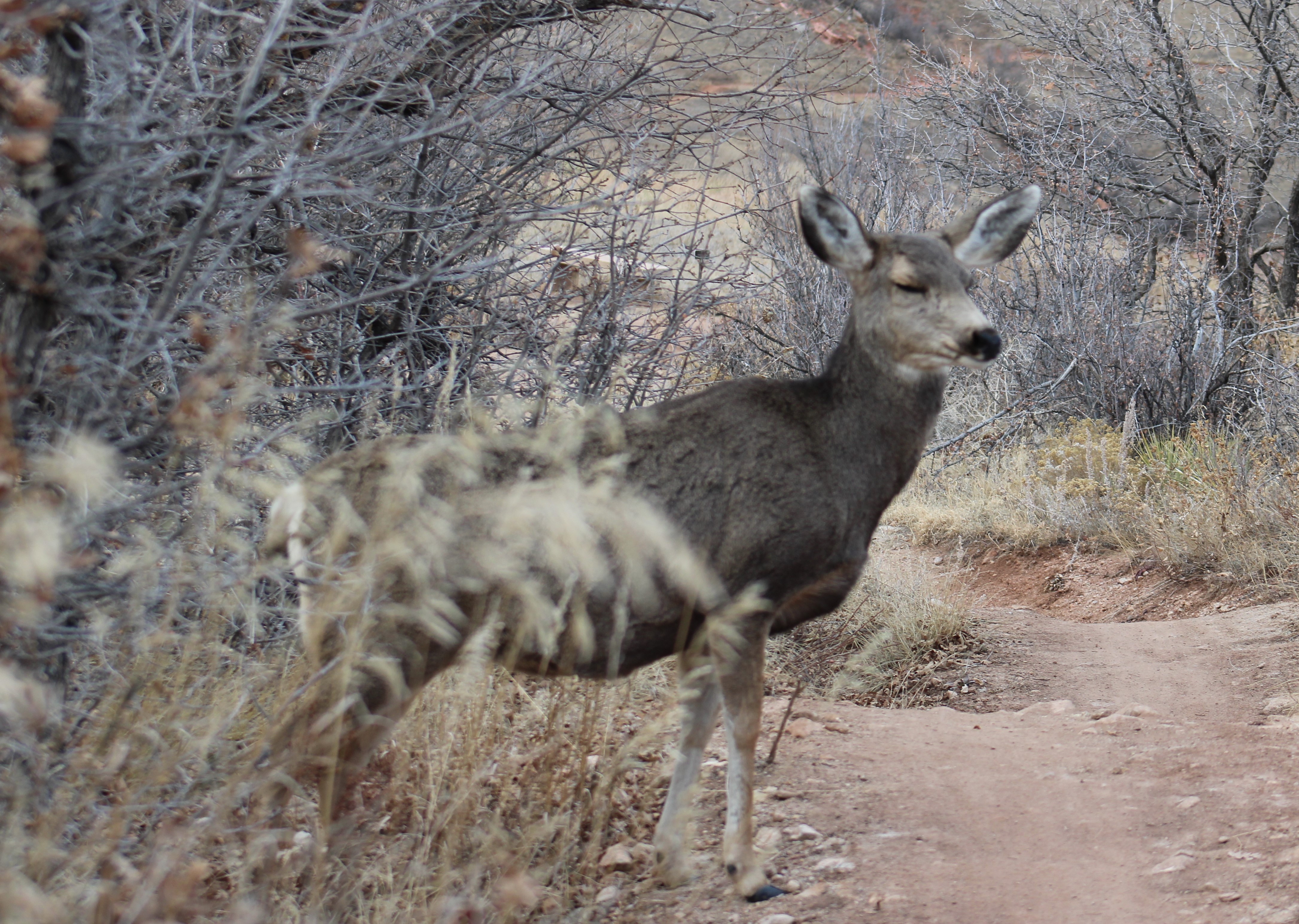
Thankfully, I would have plenty more time and opportunities that evening to get a few good pictures, as that doe was far from alone. Not only was she accompanied by her two yearling fawns. She was part of an entire harem of does and one two-point buck, who were making their way eastward, up and over the hogback to the valley on the other side.
Of course, I stayed put and just watched in awe as the deer not only crossed the trail ahead of me, but actually began to drift closer to me. It wasn't like they didn't know I was there. I was dressed in my blue Gig Harbor hoodie, blue jeans, and bright red Colorado hat, and I didn't bother to stay too quiet either. They just didn't really mind that I was there. In fact, I'm pretty sure they all recognized me, and knew I wasn't a threat.
Soon, the two yearling fawns appeared from the thicket of Gambel oak mama came from. They were a little more wary of me than the rest of the herd, but seemed to trust that I wasn't gonna hurt them. So, they carefully stepped across the path, their heads low in search of edible foliage, but their ears high and alert.
Just as the two fawns came into view, a forky buck plodded on ahead of them. I was surprised to see such a small, young buck with so many does to himself. There's a buck in the valley known by the rangers as "El Jefe", who dons freakishly huge and pointy antlers, and is about twice as large as that little forky. Regardless, the forky seemed to be very proud of his harem of eight or ten does. Perhaps, El Jefe was bedded down in someone's lawn taking a break from harassing the does, while Forky played the roll of "the boss" for a time.
Again, I aimed my camera at the deer and snapped a few photos. While they were all still very close to me, I was able to back up from them just enough to get the camera to focus in on them. Meanwhile, mama was just to my right, almost within petting distance, chewing on some late-season edible grass as I shot pictures of Forky and those fluffy winter fawns.
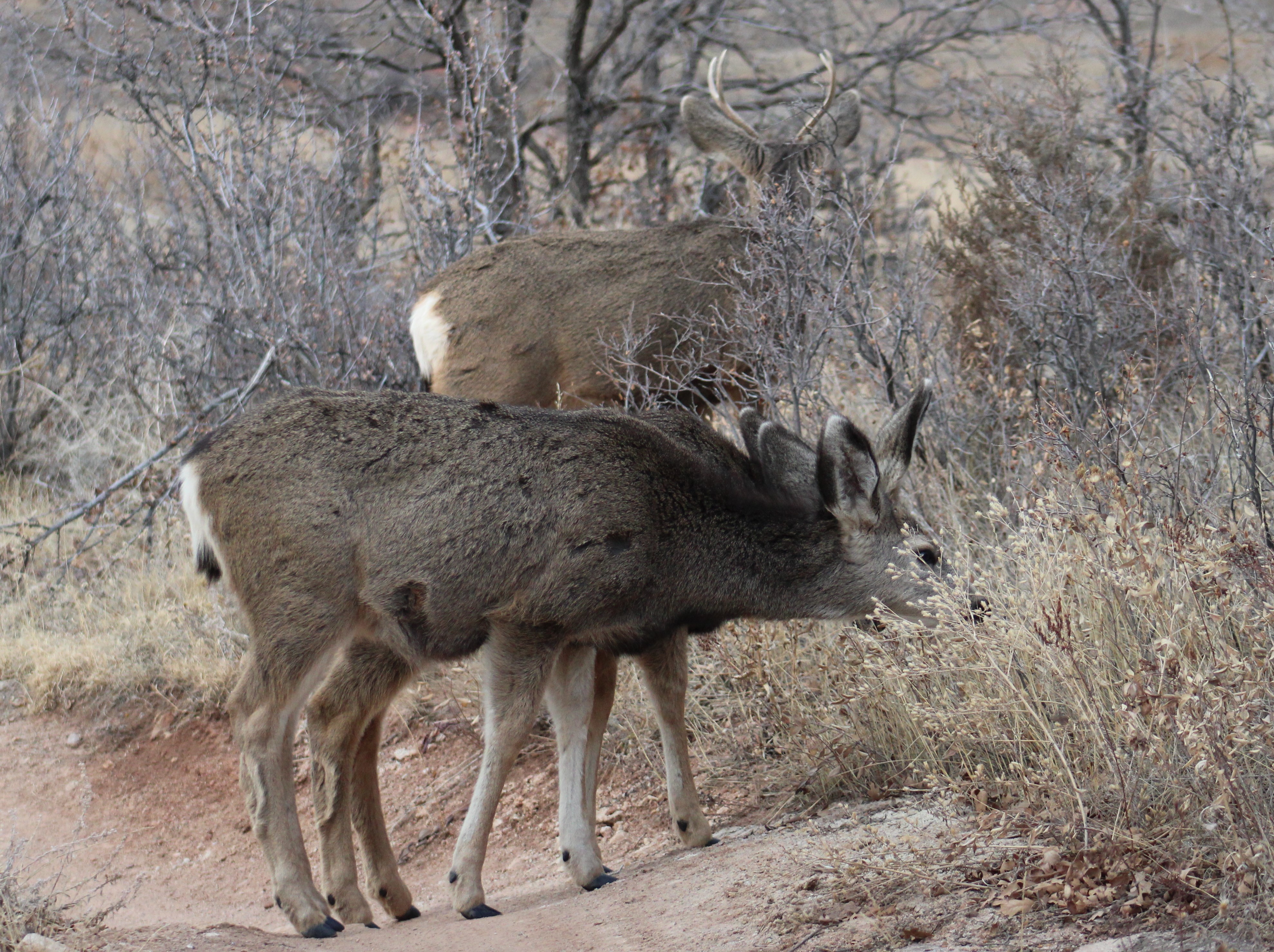
As I was taking pictures of them, I noticed that the fawns were sifting through the grass in search of sagebrush and acorns. Contrary to popular belief, Mule Deer don't usually eat grass, mostly because they have small stomachs and grass isn't as nutritionally valuable as plants like sagebrush, cacti, and seeds from trees and bushes.
Unfortunately, due to human expansion, ignorance, and, to put it more bluntly, utter stupidity, Mule Deer are having a harder and harder time finding enough resources to survive. Their numbers have been steadily declining over the last twenty years or so, due to continuously losing their habitat. In fact, Mule Deer are the only North American game animals whose population has been declining. Clearly, something is very wrong!
Invasive plants such as Cheatgrass, Musk Thistles, Common Mullein, and Toadflax have wreaked havoc in a lot of places across the west, including (and especially) in Ken Caryl Valley, which has only made things harder for Mule Deer. Having non-native grass lawns ain't helping with the decline of Muleys either, though I'm not sure how to even begin convincing the citified Karens who run the HOA to allow people to let their lawns "grow wild" in the valley, let alone ban non-native lawns altogether.
However, I find hope and peace in the fact that the valley Muleys are tough little creatures. And there are people, while fairly few and far between in Ken Caryl, who are actively trying to help Mule Deer (and all other native species of wildlife) survive and thrive. Last summer, a large volunteer group made up of residents and valley rangers went out and culled invasive species, then planted native foliage for the Mule Deer to graze. Thanks to this, I've come across large patches of silver sage, rabbitbrush, prickly pear cacti, and other Mule Deer food that were deliberately planted by the volunteers.
In fact, when I found a break in the Gambel Oak to see where those deer were coming from, I saw a doe happily grazing in the center of a huge patch of silver sage, while more does were either resting or grazing nearby. Slowly, the deer were making their way up and over the hogback from the neighborhood, presumably to where they'd bed down for the night.

I stayed in my place and just let the deer come to me. Mama, the two fawns, and Forky seemed to be going further east at first. But, then they changed course and started wandering closer to me, up the hogback towards the south. They got very close to me, in fact. So, I was forced to momentarily use my iPhone instead of my new toy to catch pictures of the deer, as I was having trouble getting a good picture of the deer using the long-range lens I had on the camera. Plus, it would be interesting to compare picture quality between the Rebel T7 camera and my iPhone.
Holding the T7 with one hand and my iPhone with the other, I got some good shots of the deer with my iPhone just to showcase how close I was to them. The deer largely ignored me, until I called out to them to get them to look at me for some pictures with my iPhone. Even then, only the fawn closest to me looked up for a brief second when I called out to them, before going back to browsing the land for nutritious foliage with her sister.

Suddenly, Forky sneezed, startling both the fawns and me. But, we all quickly calmed down once we saw the culprit licking his nose and lightly shaking his head. That's when I noticed my camera was focused on him again, as he wasn't too close, and the two fawns had bounded to my right when the buck sneezed.
Now, deer make a number of noises to communicate with each other, such as grunts, bleats, and warning blows (which usually happen in a series). But, the noise the buck made wasn't a warning blow. He had simply gotten a branch up his nose and... well... sneezed. Immediately after sneezing that one time, the buck was back to gnawing on twigs, in perfect view of my camera.

Moments later, behind me, I heard a deer give an actual warning blow. It was another doe up the trail from me, who was fixated on my camera pack I'd left on a pile of rocks alongside the trail. This doe was a couple years old, and didn't know what to make of my black square camera pack. I watched her cautiously approach the pack, her ears and head high as she stared it down. But, she was also curious, and was gradually making her way towards the scary looking solid square. Even better, she was within perfect view of my camera, so I used that as an opportunity to get some good, clear pictures of her.
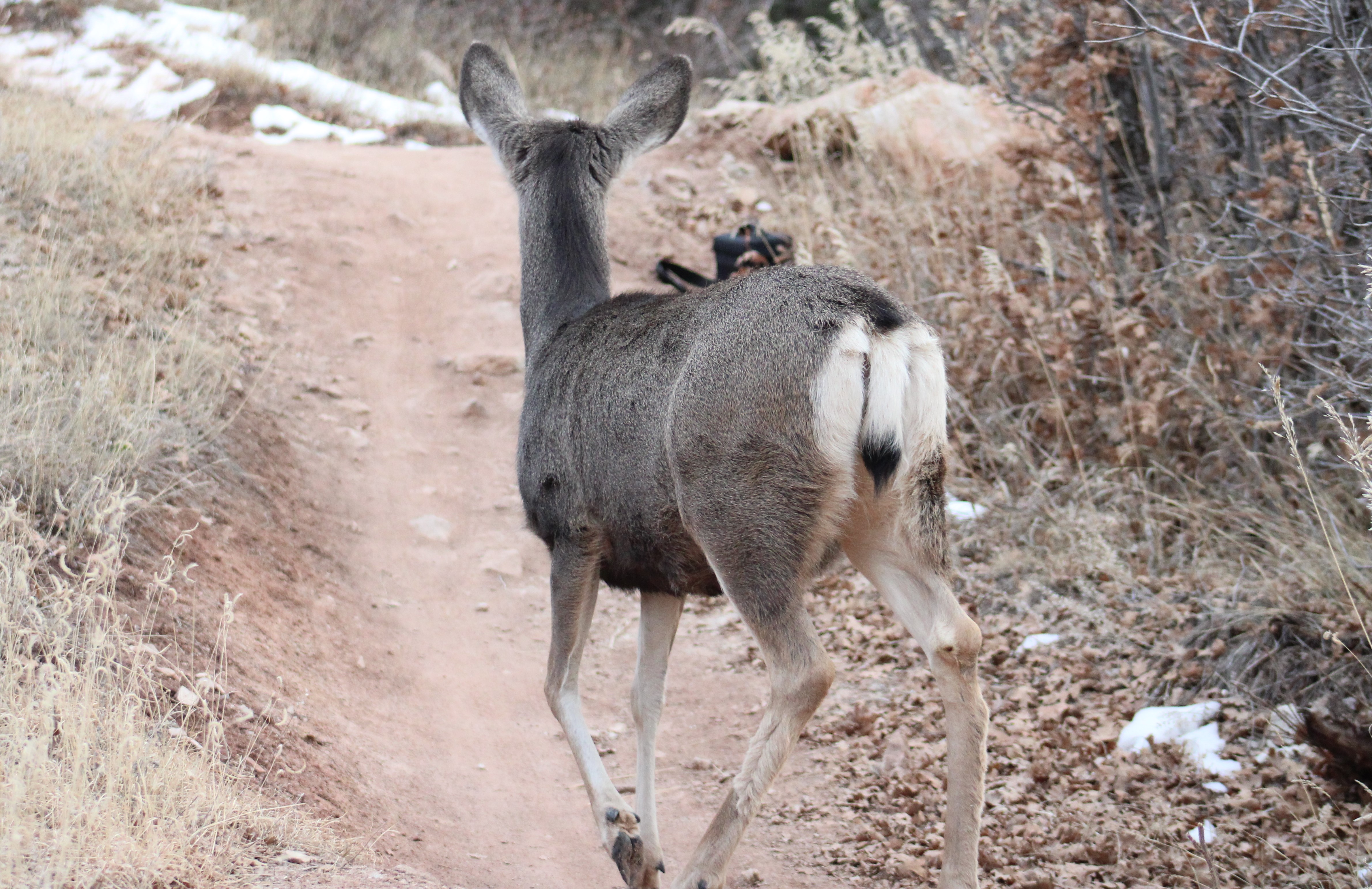
Only the two fawns heeded the doe's warning blow, and watched with wide eyes and high ears as the doe checked out the camera pack. Meanwhile, Mama doe was deep in the brush on the other side of the trail, picking leftover acorns off the higher twigs of the Gambel Oak. She seemed to think that the other doe's warning blow was over nothing, and was gnawing acorns off the branches with her ears relaxed and to the side. Her fawns quickly lost interest in the camera pack doe, and decided to follow Mama's lead in chowing down on acorns in the trees. And, that also allowed me plenty of time to get some actually good close-up shots of Mama and her two fawns in the Gambel Oaks.
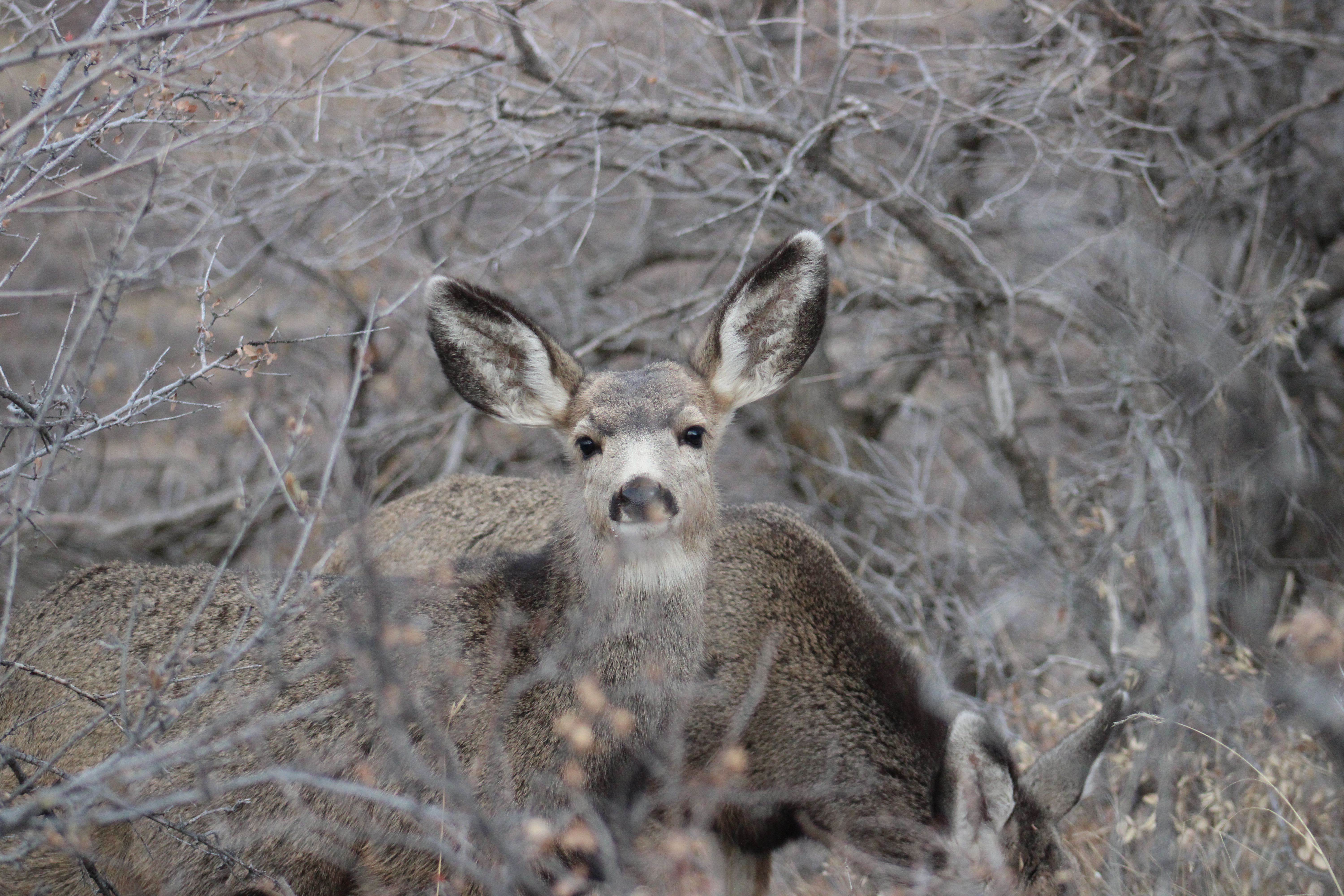
The Fawns
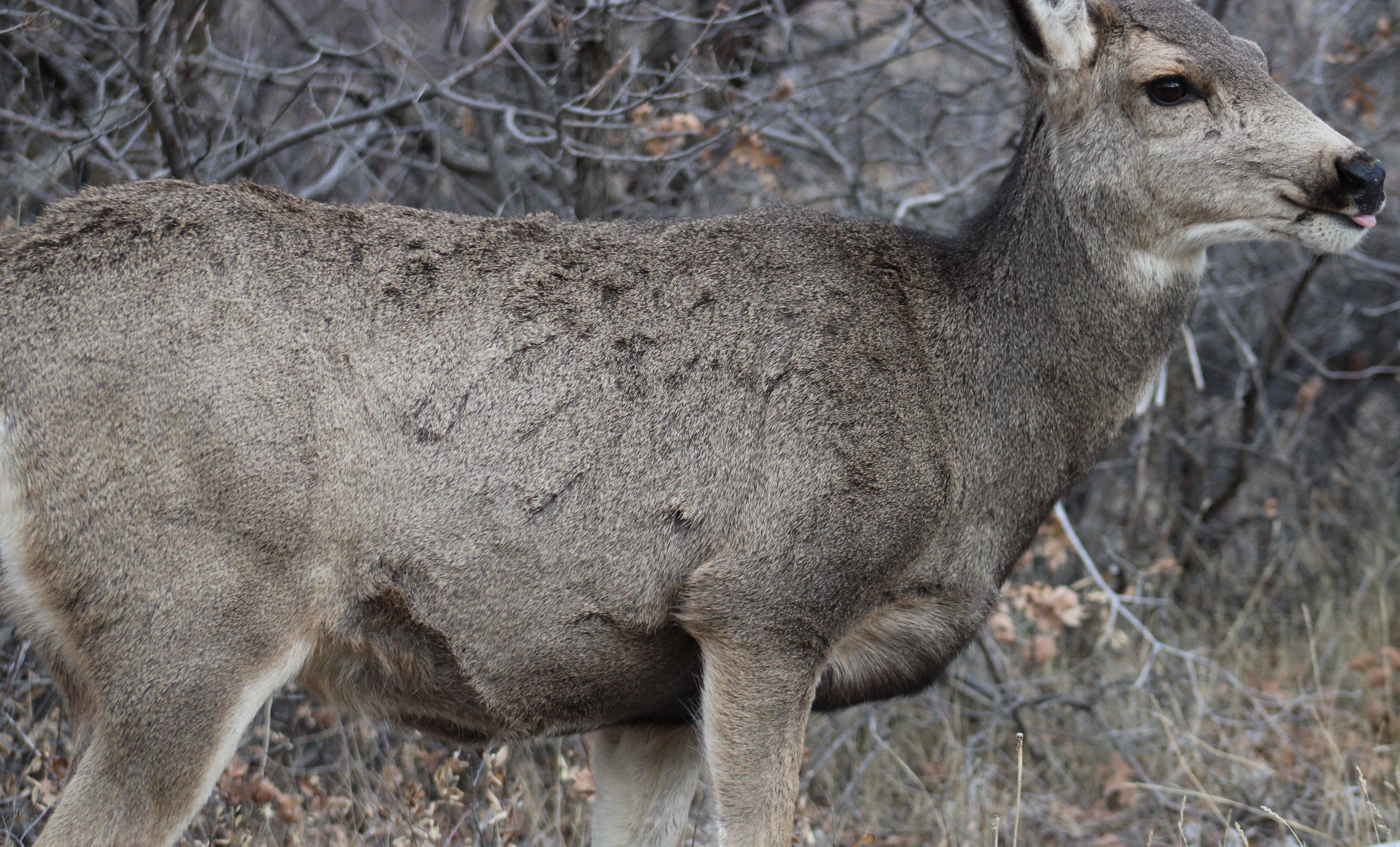
Mama chewing on some acorns
More and more does made their presence known as they bounded through the brush from the west, slowing down right along the trail I was on. None of the new does cared that I was there. They were almost too focused on food to notice that I was standing just feet away from them, camera and phone both in-hand.
Overall, I counted about ten does and one buck with me on the hogback. And I was in the center of the herd, just standing with a huge stupid grin across my face. Simply put, I was in heaven, standing among all those Muleys on the hogback.
Unfortunately, it was getting cold and dark. I didn't want to be stuck on the hogback at dusk. Last time I stayed out past sunset in the valley, I heard a bobcat screaming its head off, which scared me shitless! Not wanting to hear such a haunting sound again while in the wilderness alone, I thanked the deer for letting me get so close to them, packed away my gear, and headed back to my truck.

